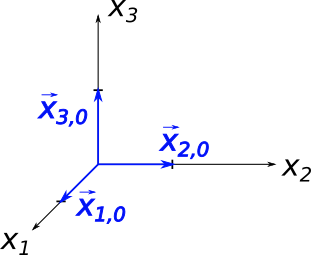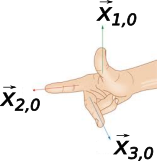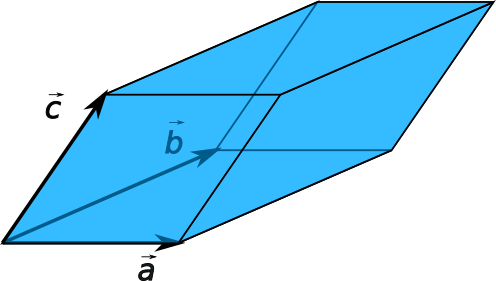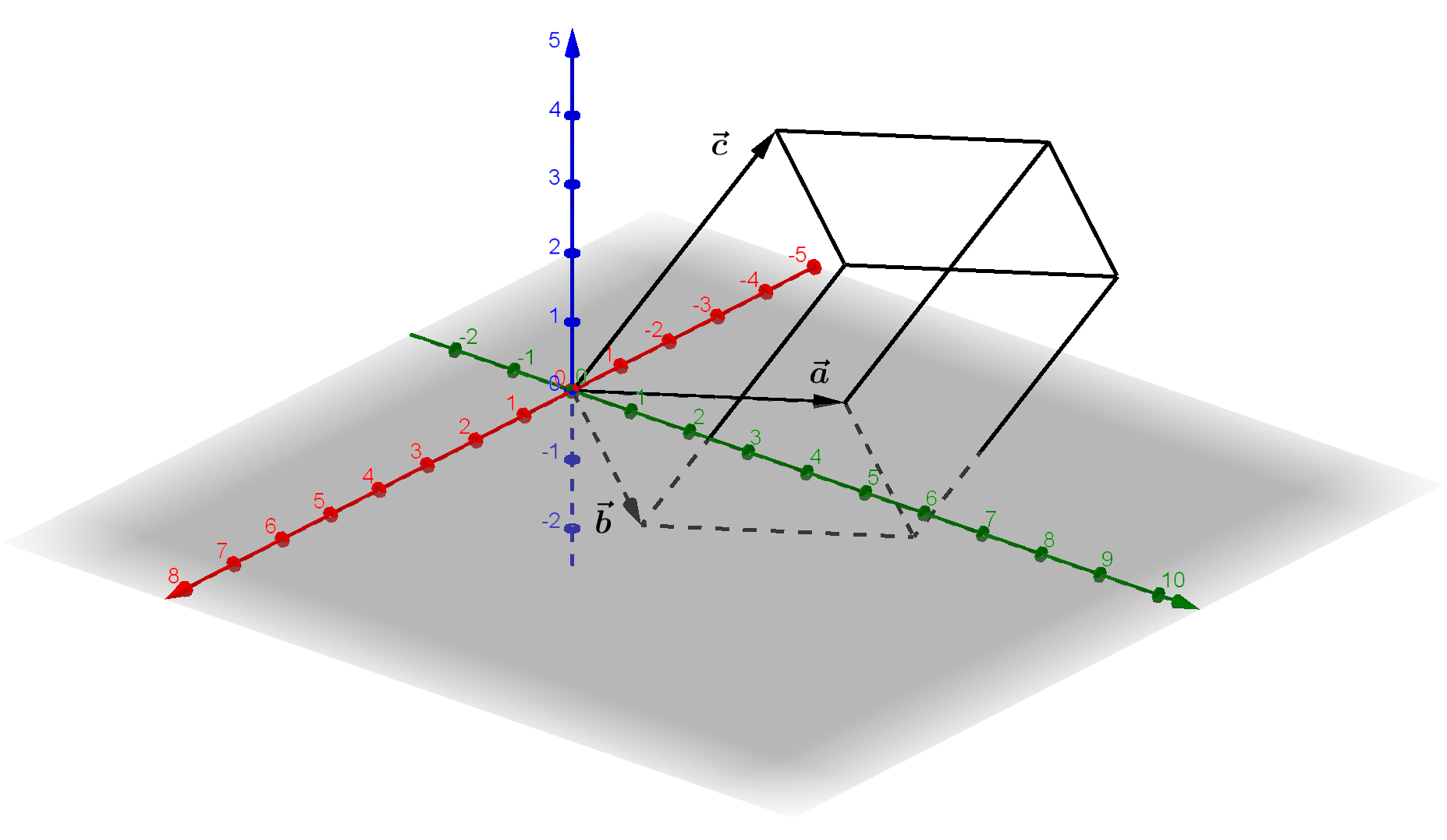


Das kartesische Koordinatensystem ist so aufgebaut, dass das Vektorprodukt der $x_1$-Achse mit der $x_2$-Achse genau die $x_3$-Achse ergibt. Es gilt
also:
$$
\vec x_1 \times \vec x_2 = \vec x_3
$$
In diesem Sinne kann auch die Vektormultiplikation der Einheitsvektoren der Koordinatenachsen aufgefasst werden:
$$
\vec x_{1,0} \times \vec x_{2,0} = \vec x_{3,0}
$$
Wichtig ist hier vor allem die Reihenfolge. Mit der rechten Hand-Regel kann man sich die Reihenfolge klar machen. Der Daumen zeigt in die $x_1$-Richtung,
der Zeigefinger in die $x_2$-Richtung und der Mittelfinger in die $x_3$-Richtung. Zwischen den Fingern befindet sich jeweils ein rechter Winkel.
 Die Reihenfolge ist immer Daumen - Zeigefinger - Mittelfinger - Daumen - Zeigefin... und immer so weiter. Es ist egal, wo man anfängt. Man erhält
also z.B. die folgenden Vektorprodukte:
\begin{align}
\vec x_{1,0} \times \vec x_{2,0} &= \vec x_{3,0} \\ \\
\vec x_{2,0} \times \vec x_{3,0} &= \vec x_{1,0} \\ \\
\vec x_{3,0} \times \vec x_{1,0} &= \vec x_{2,0}
\end{align}
Es gelten weiterhin die folgenden Zusammenhänge:
\begin{align}
\vec x_{1,0} \times \vec x_{1,0} = \vec x_{2,0} \times \vec x_{2,0} = \vec x_{3,0} \times \vec x_{3,0} = 0
\end{align}
Die Reihenfolge ist immer Daumen - Zeigefinger - Mittelfinger - Daumen - Zeigefin... und immer so weiter. Es ist egal, wo man anfängt. Man erhält
also z.B. die folgenden Vektorprodukte:
\begin{align}
\vec x_{1,0} \times \vec x_{2,0} &= \vec x_{3,0} \\ \\
\vec x_{2,0} \times \vec x_{3,0} &= \vec x_{1,0} \\ \\
\vec x_{3,0} \times \vec x_{1,0} &= \vec x_{2,0}
\end{align}
Es gelten weiterhin die folgenden Zusammenhänge:
\begin{align}
\vec x_{1,0} \times \vec x_{1,0} = \vec x_{2,0} \times \vec x_{2,0} = \vec x_{3,0} \times \vec x_{3,0} = 0
\end{align}
\begin{align} \vec x_{1,0} \times \vec x_{2,0} = - \left( \vec x_{2,0} \times \vec x_{1,0} \right) &= \vec x_{3,0} \\ \\ \vec x_{3,0} \times \vec x_{1,0} = - \left( \vec x_{1,0} \times \vec x_{3,0} \right) &= \vec x_{2,0} \\ \\ \vec x_{2,0} \times \vec x_{3,0} = - \left( \vec x_{3,0} \times \vec x_{2,0} \right) &= \vec x_{1,0} \\ \\ \end{align}
Zwei weitere Rechengesetze sind: \begin{align} \vec a \times \left( \vec b + \vec c \right) &= \vec a \times \vec b + \vec a \times \vec c \\ \\ \left( r \cdot \vec a \right) \times \vec b &= r \cdot \left( \vec a \times \vec b \right) \end{align}
Zerlegt man die beiden Vektoren $\vec a$ und $\vec b$ in ihre Bestandteile, insbesondere mit den Richtungseinheitsvektoren, erhält man: \begin{align} \vec a &= a_1 \cdot \vec x_{1,0} + a_2 \cdot \vec x_{2,0} + a_3 \cdot \vec x_{3,0} \\ \\ \vec b &= b_1 \cdot \vec x_{1,0} + b_2 \cdot \vec x_{2,0} + b_3 \cdot \vec x_{3,0} \end{align}
Für das Vektorprodukt $\vec a \times \vec b$ ergibt sich zunächst, wenn der Vektor $\vec b$ durch den obigen Ausdruck ersetzt wird: \begin{align} \vec a \times \vec b = \vec a \times \left( b_1 \cdot \vec x_{1,0} + b_2 \cdot \vec x_{2,0} + b_3 \cdot \vec x_{3,0} \right) \end{align} Mit dem ersten der angegebenen Rechengesetze wird das zu: \begin{align} = \vec a \times b_1 \cdot \vec x_{1,0} + \vec a \times b_2 \cdot \vec x_{2,0} + \vec a \times b_3 \cdot \vec x_{3,0} \end{align} Wird der Vektor $\vec a$ in der zerlegten Form in den Ausdruck eingesetzt, folgt: \begin{align} = \left( a_1 \cdot \vec x_{1,0} + a_2 \cdot \vec x_{2,0} + a_3 \cdot \vec x_{3,0} \right) \times b_1 \cdot \vec x_{1,0} \\ + \left( a_1 \cdot \vec x_{1,0} + a_2 \cdot \vec x_{2,0} + a_3 \cdot \vec x_{3,0} \right) \times b_2 \cdot \vec x_{2,0} \\ + \left( a_1 \cdot \vec x_{1,0} + a_2 \cdot \vec x_{2,0} + a_3 \cdot \vec x_{3,0} \right) \times b_3 \cdot \vec x_{3,0} \end{align} Mit dem ersten Rechengesetz ergibt sich: \begin{align} = a_1 \cdot \vec x_{1,0} \times b_1 \cdot \vec x_{1,0} + a_2 \cdot \vec x_{2,0} \times b_1 \cdot \vec x_{1,0} + a_3 \cdot \vec x_{3,0} \times b_1 \cdot \vec x_{1,0} \\ + a_1 \cdot \vec x_{1,0} \times b_2 \cdot \vec x_{2,0} + a_2 \cdot \vec x_{2,0} \times b_2 \cdot \vec x_{2,0} + a_3 \cdot \vec x_{3,0} \times b_2 \cdot \vec x_{2,0} \\ + a_1 \cdot \vec x_{1,0} \times b_3 \cdot \vec x_{3,0} + a_2 \cdot \vec x_{2,0} \times b_3 \cdot \vec x_{3,0} + a_3 \cdot \vec x_{3,0} \times b_3 \cdot \vec x_{3,0} \end{align} Wird das zweite Rechengesetz angewendet, folgt: \begin{align} = a_1 \cdot b_1 \left(\vec x_{1,0} \times \vec x_{1,0} \right) + a_2 \cdot b_1 \left(\vec x_{2,0} \times \vec x_{1,0} \right) + a_3 \cdot b_1 \left(\vec x_{3,0} \times \vec x_{1,0} \right) \\ + a_1 \cdot b_2 \left(\vec x_{1,0} \times \vec x_{2,0} \right) + a_2 \cdot b_2 \left(\vec x_{2,0} \times \vec x_{2,0} \right) + a_3 \cdot b_2 \left(\vec x_{3,0} \times \vec x_{2,0} \right) \\ + a_1 \cdot b_3 \left(\vec x_{1,0} \times \vec x_{3,0} \right) + a_2 \cdot b_3 \left(\vec x_{2,0} \times \vec x_{3,0} \right) + a_3 \cdot b_3 \left(\vec x_{3,0} \times \vec x_{3,0} \right) \end{align} Mit den oben angegebenen Zusammenhängen zwischen den Richtungseinheitsvektoren folgt: \begin{align} = 0 + a_2 \cdot b_1 \left(- \vec x_{3,0} \right) + a_3 \cdot b_1 \left(\vec x_{2,0} \right) \\ + a_1 \cdot b_2 \left(\vec x_{3,0} \right) + 0 + a_3 \cdot b_2 \left(- \vec x_{1,0} \right) \\ + a_1 \cdot b_3 \left(- \vec x_{2,0} \right) + a_2 \cdot b_3 \left(\vec x_{1,0} \right) + 0 \end{align} Sortiert man das nach den Einheitsvektoren, bekommt man: \begin{align} = a_2 \cdot b_3 \left(\vec x_{1,0} \right) - a_3 \cdot b_2 \left(\vec x_{1,0} \right) \\ + a_3 \cdot b_1 \left(\vec x_{2,0} \right) - a_1 \cdot b_3 \left(\vec x_{2,0} \right) \\ + a_1 \cdot b_2 \left(\vec x_{3,0} \right) - a_2 \cdot b_1 \left(\vec x_{3,0} \right) \end{align} Insgesamt folgt für das Vektorprodukt die folgende Berechnungsvorschrift: \begin{align} \vec a \times \vec b = \left( \begin{array}{} a_2 \cdot b_3 - a_3 \cdot b_2 \\ a_3 \cdot b_1 - a_1 \cdot b_3 \\ a_1 \cdot b_2 - a_2 \cdot b_1 \end{array} \right) \end{align}
 Die zwei Vektoren $\vec a$ und $\vec b$ bilden zwei Seiten eines Parallelogramms. Der Betrag des Vektorprodukts $ \lvert \vec a \times \vec b \rvert$
entspricht dem Flächeninhalt des Parallelogramms.
Die zwei Vektoren $\vec a$ und $\vec b$ bilden zwei Seiten eines Parallelogramms. Der Betrag des Vektorprodukts $ \lvert \vec a \times \vec b \rvert$
entspricht dem Flächeninhalt des Parallelogramms.
Beispiel:
Ein Parallelogramm wird durch die beiden Vektoren $\vec a = \left( \begin{array}{} 0 \\ 3 \\ 0 \end{array} \right)$ und $\vec b = \left( \begin{array}{} 2 \\ 1 \\ 0 \end{array} \right)$
aufgespannt.
Das Vektorprodukt ergibt:
\begin{align}
\left( \begin{array}{} 0 \\ 3 \\ 0 \end{array} \right) \times \left( \begin{array}{} 2 \\ 1 \\ 0 \end{array} \right) = \left( \begin{array}{} 0 \\ 0 \\ -6 \end{array} \right)
\end{align}
Der Betrag des Vektorprodukts ist dann:
\begin{align}
\lvert \vec a \times \vec b \rvert = 6
\end{align}
Der Flächeninhalt des Parallelogramms ist damit 6 FE.
 Ein Parallelepiped ist ein Körper, der aus sechs paarweise parallelen Parallelogrammen zusammengesetzt wird.
Ein Parallelepiped ist ein Körper, der aus sechs paarweise parallelen Parallelogrammen zusammengesetzt wird.
Für die Bestimmung des Volumens eines Parallelepipeds ist das Spatprodukt geeignet. Hier werden Vektor- und Skalarprodukt genutzt.
Man kann für das Spatprodukt aus den drei Vektoren $\vec a$, $\vec b$ und $\vec c$ schreiben:
\begin{align}
\left( \vec a , \vec b , \vec c \right) = \left( \vec a \times \vec b \right) \cdot \vec c
\end{align}
Der Betrag des Ergebnisses ist das Volumen des Epipeds.
Beispiel:
Gegeben sind die Vektoren $\vec a = \left( \begin{array}{} -2 \\ 3 \\ 0 \end{array} \right)$, $\vec b = \left( \begin{array}{} 1 \\ 2 \\ -1 \end{array} \right)$
und $\vec c = \left( \begin{array}{} -3 \\ 1 \\ 3 \end{array} \right)$, wie sie in der Abbildung zu sehen sind.

Für das Spatprodukt erhält man:
\begin{align}
\left( \vec a , \vec b , \vec c \right) &= \left( \left( \begin{array}{} -2 \\ 3 \\ 0 \end{array} \right) \times \left( \begin{array}{} 1 \\ 2 \\ -1 \end{array} \right) \right) \cdot
\left( \begin{array}{} -3 \\ 1 \\ 3 \end{array} \right) \\ \\
\left( \vec a , \vec b , \vec c \right) &= \left(\begin{array}{} 3 \cdot (-1) - 2 \cdot 0 \\ 0 \cdot 1 - (-1) \cdot (-2) \\ (-2) \cdot 2 - 1 \cdot 3 \end{array} \right) \cdot
\left( \begin{array}{} -3 \\ 1 \\ 3 \end{array} \right) \\ \\
\left( \vec a , \vec b , \vec c \right) &= \left(\begin{array}{} -3 \\ -2 \\ -7 \end{array} \right) \cdot \left( \begin{array}{} -3 \\ 1 \\ 3 \end{array} \right) \\ \\
\left( \vec a , \vec b , \vec c \right) &= (-3) \cdot (-3) + (-2) \cdot 1 + (-7) \cdot 3 \\ \\
\left( \vec a , \vec b , \vec c \right) &= -14
\end{align}
Das Volumen ist also $V = 14 \, \text{VE}$.
© mondbrand MMXIX